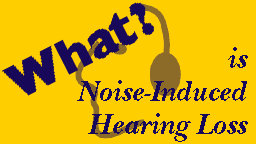

Audiograms are one of the tools health care providers use to identify a hearing loss. Below are links to sample audiograms showing one example of a normal audiogram, as well as an example of an audiogram demonstrating hearing loss from noise exposure. Note how the damage from noise is most noticeable in the highest frequencies.
 Audiogram of Normal Hearing (11 k)
Audiogram of Normal Hearing (11 k)
 Audiogram of Hearing Loss (11 k)
Audiogram of Hearing Loss (11 k)
![[diagram of the inner ear]](sally_images/sallyear.gif)
The human ear is a well-tuned machine. The tiny hair cells lining the cochlea respond to vibrations (amplified by the ear drum and the middle ear bones) and send signals to the brain, alerting us to sounds.
The hair cells can be worn out by long periods of loud sounds (or short blasts of extremely loud sounds). Then the signals don't reach the brain and we can't perceive those sounds. And, the hair cells are not replaceable parts; only the original equipment works.
Hearing protectors reduce the wear on the hair cells by blocking noise and reducing it to a safe level, without preventing you from hearing sounds around you.
Below is a QuickTime video showing damage to the hair cells. First you see the cells as they would be when not experiencing sound stimulation. Then the cells lay over like wet grass, demonstrating a fairly long exposure to loud sound. Because the exposure is so long (relatively), the cells do not bounce back to their normal position, but instead become damaged.
 QuickTime Animation (1.1 M) of damage to hair cells inside the cochlea.
QuickTime Animation (1.1 M) of damage to hair cells inside the cochlea.
![[sound sources and their sound levels (e.g. power tools are 100 dB)]](sally_images/sallynoise.gif)
There are four basic types of hearing protection listed below; each offers different advantages and options. With all of these choices, you need to try different types until you find one that feels comfortable, properly blocks out noise, and works for your activities. Ask around...you may learn your co-workers use a variety of types. If the type of hearing protection generally available at your job sites works for you, great. Stick with it! If not, find a type and style that fits your needs.
Fit is very important for all types of hearing protectors: no one wants to wear shoes that don't fit well. The same is true of hearing protection! It's up to you to make sure your protectors fit, are comfortable, and effective. Here's how:



